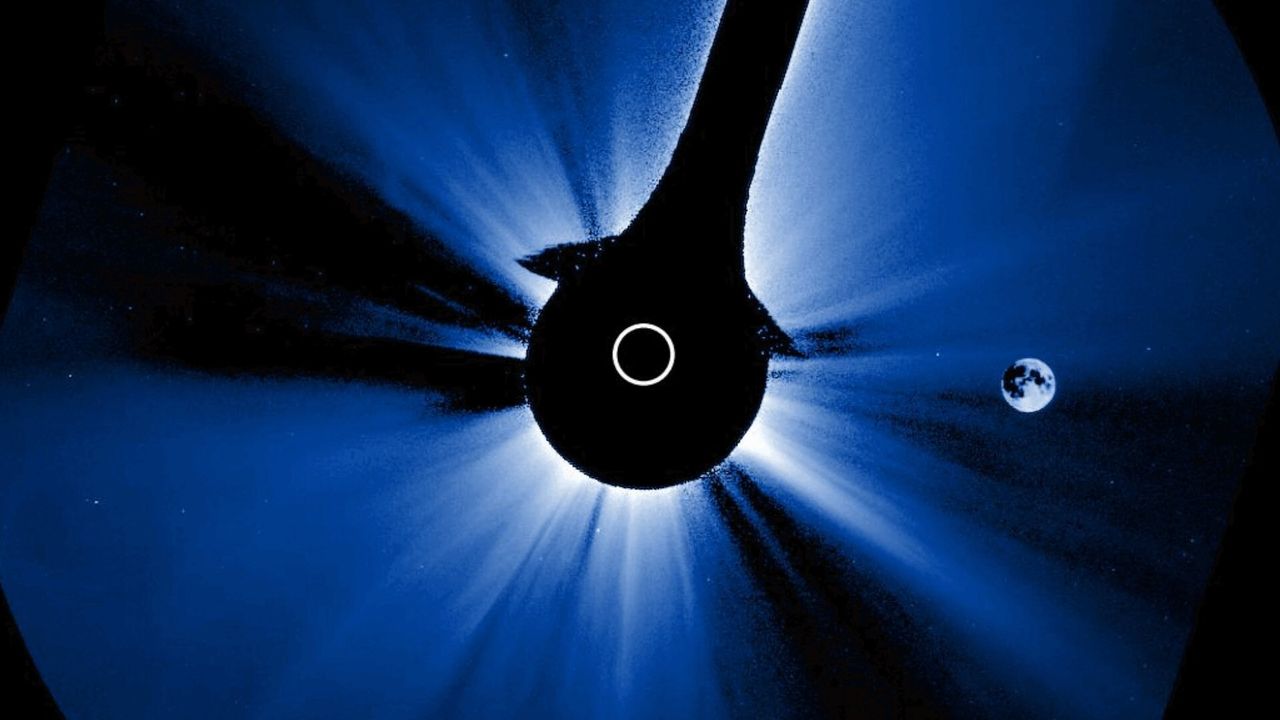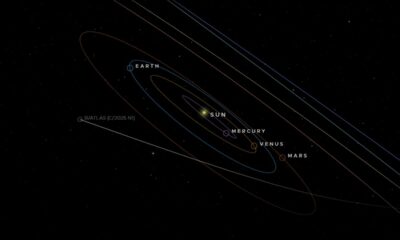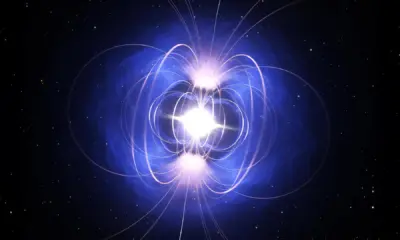Science
NOAA’s Coronagraph Captures Moon Passing in Front of the Sun

A remarkable image captured by the National Oceanic and Atmospheric Administration’s (NOAA) Compact Coronagraph-1 (CCOR-1) reveals the moon photobombing the sun. This extraordinary phenomenon occurred as the CCOR-1, positioned on the GOES-19 satellite, observed the sun’s corona, the outer atmosphere that is typically obscured by the sun’s intense brightness.
Innovative Technology in Solar Observation
The CCOR-1 was launched in June 2024 to enhance the study of solar activity. Unlike its predecessors, which are located further from Earth, this coronagraph operates from a geostationary orbit just above the equator. This unique positioning allows it to provide unprecedented views of solar phenomena and other celestial bodies, including the moon.
By employing an occulting disk, the CCOR-1 effectively simulates a solar eclipse, enabling scientists to focus on the sun’s fainter corona. This technique helps researchers analyze solar winds and other critical solar activities that can significantly impact Earth’s space weather.
A Unique Encounter
In a recent image, the moon was seen moving across the coronagraph’s field of view, almost directly obscuring the sun. This occurrence is relatively rare, as most coronagraphs are located further away and cannot capture such close interactions. The proximity of the CCOR-1 to Earth means that occasional lunar transits can be observed, providing valuable data for solar research.
Interestingly, although the moon appears nearly full in the image, it is not a full moon. The brightness seen in the photograph results from Earthshine—sunlight reflecting off the Earth’s surface and illuminating the moon. The CCOR-1’s high-resolution capabilities enabled it to capture this phenomenon vividly.
The implications of this technology extend beyond mere curiosity. NOAA plans to equip future GOES satellites with similar coronagraphs to continue advancing our understanding of solar dynamics. This ongoing research is vital for predicting space weather events that can affect satellite communications and power grids on Earth.
The recent image serves as a reminder of how innovative technology can enhance our understanding of both the sun and its relationship with other celestial bodies. For those interested in further exploring NOAA’s solar research, additional resources are available through their official channels.
-

 Technology5 months ago
Technology5 months agoDiscover the Top 10 Calorie Counting Apps of 2025
-

 Technology2 weeks ago
Technology2 weeks agoOpenAI to Implement Age Verification for ChatGPT by December 2025
-

 Health3 months ago
Health3 months agoBella Hadid Shares Health Update After Treatment for Lyme Disease
-

 Health3 months ago
Health3 months agoAnalysts Project Stronger Growth for Apple’s iPhone 17 Lineup
-

 Health3 months ago
Health3 months agoErin Bates Shares Recovery Update Following Sepsis Complications
-

 Technology5 months ago
Technology5 months agoDiscover How to Reverse Image Search Using ChatGPT Effortlessly
-

 Technology3 months ago
Technology3 months agoElectric Moto Influencer Surronster Arrested in Tijuana
-

 Technology2 months ago
Technology2 months agoDiscover 2025’s Top GPUs for Exceptional 4K Gaming Performance
-

 Technology5 months ago
Technology5 months agoMeta Initiates $60B AI Data Center Expansion, Starting in Ohio
-

 Technology5 months ago
Technology5 months agoRecovering a Suspended TikTok Account: A Step-by-Step Guide
-

 Health5 months ago
Health5 months agoTested: Rab Firewall Mountain Jacket Survives Harsh Conditions
-

 Lifestyle5 months ago
Lifestyle5 months agoBelton Family Reunites After Daughter Survives Hill Country Floods





















